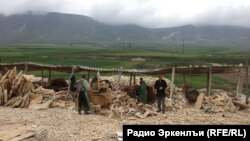Over the past three years, Russian media have periodically reported the release from slavery of men forced against their will to work at Daghestan's numerous brickworks.
The most recent such victim, a man from Murmansk rescued by the public organization Alternativa, claims to have been held for 18 years as a slave in Daghestan, where he worked first at a brickworks and then, after an unsuccessful attempt to escape, as a cattle herder.
According to Alternativa, the man was the fifth whose release they have secured so far this year, compared with at least 12 in 2013. In some cases, the victims (most of them Russians, but also some from Belarus) said they were drugged after signing a work contract in Moscow or Yekaterinburg, and transported unconscious to Daghestan.
Daghestan's prosecutor's office announced one year ago, however, that inspections of brickworks in the towns of Makhachkala, Kaspiisk, Kizlyar, and Kizilyurt and in the Babayurt, Kizilyurt, and Karabudakhkent districts failed to yield any evidence of the use of involuntary or slave labor. Those inspections did, however, uncover numerous unspecified violations of labor, land, and tax legislation and of health and safety regulations.
Assuming that the workers who managed to escape, and whose escape was reported in the media, constitute the tip of the iceberg, calculating how many may remain in semicaptivity is problematic. In March 2013, an official from the Makhachkala prosecutor's office for nature conservation told parliament officials that "until recently," there had been a total of 86 functioning brickworks in Daghestan, 39 of them in Makhachkala and the coastal town of Kaspiisk. One month later, Daghestan's Ecology and Natural Resources Minister Gasan Idrisov cited a figure of 27 for Makhachkala and Kaspiisk.
But no estimates have been made public of the proportion of those enterprises that employ slave labor. Commenting on the release in January 2013 by Alternativa activists of nine laborers, five of them from Belarus, then-Daghestan Information Minister Nariman Gadzhiyev admitted that "slave labor is not a rare occurrence in Daghestan," and that it was not confined to the construction industry. In May 2013, police launched an investigation after one Daghestani blogger claimed there was a functioning slave market behind one of the city's cinemas where it was possible to purchase a male slave for 15,000 rubles ($380 at today's exchange rate).
On the whole, the republic's authorities appear more concerned by the aesthetic and ecological impact of the brickworks and their importance for the republic's economy than the status of their workforce. Republic of Daghestan head Ramazan Abdulatipov complained in February that seen from the air, Makhachkala is surrounded by flooded craters from which clay for bricks has been excavated. Some of those craters are up to 150 meters in diameter and 25-30 meters deep. Other abandoned craters are used as garbage tips, although by law the brickworks owners are obliged to recultivate them.
The brickworks are inspected at intervals: four of six works in Kaspiisk inspected last month were ordered to suspend production "temporarily" to address violations of ecological and sanitary norms. But any large-scale crackdown or reduction in the total number of such enterprises is unlikely in view of the importance of the construction sector to Daghestan's ramshackle economy. According to official statistics, the Kaspiisk brickworks alone produce between 8 million-9 million tons of bricks per year.
